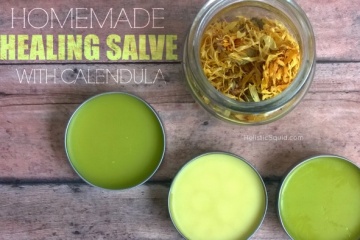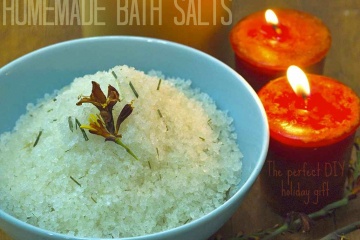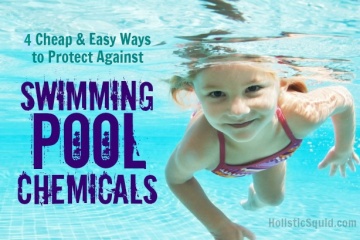

I love a natural healing salve for everything from diaper rash to sunburn to dry skin and chapped lips. Even when it comes to stubborn eczema, it can often help provide relief during the healing process. This recipe that Jamie is sharing with us today is both simple to make and works great. ~Emily
I’ve never been the type to sunburn easily, but during our childhood, my brother frequently resembled a lobster during the summer months. Unfortunately my mom didn’t know the wonders of a calendula healing salve. Calendula is my go to herb of choice for soothing and healing skin conditions, and for good reason…
Reasons to love calendula
Also known as pot marigold, this bright orange flower has been used for eczema and psoriasis, mild burns, dry skin, cuts, scrapes, stings and bites, and skin infections. It’s a powerful anti-inflammatory, anti-microbrial, anti-fungal and astringent, making it great for healing wounds. (source)
One of my favorite things about calendula though, is that it’s a very gentle herb. I had no reservations about using it on my son, even when he was a baby. Bye bye diaper rash.
I’ve also worked with dozens of children as a nanny, and unfortunately several of them have had mild to severe eczema. I’ve seen fast and effective results from using this salve on their eczema patches. To keep eczema from coming back though, you have to address the root cause through diet. For more on healing eczema from the inside out, check out Emily's book The Eczema Cure.
Supercharge your healing salve
To make this healing salve even better, you can add essential oils. I always add lavender essential oil to mine. It’s gentle enough for children, but effective enough for an adult. Frankincense and tea tree are also good choices and generally safe for children.
Lavender is antimicrobrial, antifungal, anti-inflammatory, antiseptic and regenerative. It’s been used for wounds, burns, cuts and itchy skin, among many other things. If I could only have one essential oil, it would be lavender.
Tea tree oil has been used for rashes, sunburns and general skin healing. It has antibacterial, anti-fungal, anti-viral and anti-inflammatory properties. Frankincense is my other favorite skin oil. Its anti-inflammatory, antiseptic and anti-infectious properties make it useful for scar prevention, infections, wrinkles and inflammation.
I personally didn't have an issue with using certain diluted oils on my baby, but there are differing opinions on this. Shirley Price, a highly qualified aromatherapist, recommends using 8 drops per 1.7 ounces of carrier oil for young children, or 5 drops on infants (source).
My favorite method for making healing salve
There are several ways to make a salve, but the crockpot method is my favorite. While it takes a bit longer, it's simple and very low maintenance to prepare. It also does a better job of preserving the healing properties of the herbs.
If you’re in a hurry you can also put the herbs on the stove. Although the stovetop method only takes a few hours, you have to keep a careful eye on the herbs, as they can easily burn.
When it comes to choosing an oil, my favorites are coconut, olive oil, or sweet almond. If you choose olive oil, you may find the salve is a fun green color as pictured here. When using coconut oil, you may want to opt for a quality, expeller pressed, refined oil. I've not noticed a problem with the unrefined coconut oil leaving a strong scent though, and that's what I always use.
Homemade healing salve ingredients and supplies
- Calendula flowers – get them here
- Coconut oil – get it in bulk (or use olive or sweet almond)
- Lavender essential oil (optional) – get it here
- Frankincense essential oil (optional) – get it here
- Tea tree essential oil (optional) – get it here
- Beeswax (pellets are super easy to use) – get it here
- Very clean mason jar and lid
- A large crockpot – this is the one I have
- A washcloth or other small cloth
- Water
- Small weight (like a rock)
- Saucepan
- Small, fine mesh strainer (cheesecloth will also work)
- Heat safe containers – I like these tins
Homemade healing salve method
- Fill the jar half full of dried calendula flowers. (I like to do several different oil infusions at once so I’m not running a crockpot for just one jar.) Pour oil over the dried herbs until the herbs are covered completely, but leave about ½ inch of headspace. Screw the lid on tightly.
- Place the cloth on the bottom of the crockpot and then put the jars on top of that. This helps prevent the jars from breaking. Fill the crockpot with water to the tops of the jars. I put a small rock, or other weight on them so they don’t tip over. Turn the crockpot on to the “warm” setting and let the healing salve infuse for 3 days. Add water as it evaporates so that the water remains just below the tops of the jars.
- After 3 days, turn the crockpot off and carefully remove the jars. I like using this jar grabber to avoid burning any fingers.
- Let the jars cool down until they are cool enough to handle. If you use coconut oil then you’ll have to work with the oil while it’s still very warm, but not burning. Strain the oil through a strainer or cheesecloth and into a measuring cup, preferably glass. Take note of how many ounces there are before pouring the oil into your saucepan.
- Put the pan on very low heat and add some beeswax. For every 2 ounces of oil, I like to add 1 tablespoon of beeswax pellets, but it’s not an exact science. I’ll typically add more beeswax in summer since salves like to soften in warm temperatures. Gently stir the mixture with a metal spoon until the wax is completely melted. Be sure that you have the heat on as low as possible to prevent any burning. You can also use a double boiler to be safe, but I’ve found they take much longer.
- Test the firmness of your salve. Dip the metal spoon into the salve and place it in the freezer for 1-3 minutes, just long enough for it to firm up. Add more beeswax if the consistency is too soft for you.
- Once you’ve added all the beeswax you want, carefully pour the hot salve into your containers. If you’re using essential oils, add them now. I like using a 2% dilution for salves, which is about 10 drops per 1 ounce of oil. You can add 3 drops each of frankincense, tea tree and lavender, or any combination of 10 drops you like.For children, you can dilute it to 5 drops per ounce and 3 drops for infants. Use a toothpick to gently stir the essential oils into the salve. I like adding the essential oils directly to the tins because it makes it easier to measure. Immediately put the lids on the tins so that the volatile plant oils don't evaporate in the heat. Allow to cool completely and use generously!
What's your favorite way to use a homemade healing salve?
Jamie Larrison blogs at The Herbal Spoon. She has a passion for herbalism and aromatherapy and creates her own plant-based, safe for the whole family bodycare items for her etsy shop. Learn more about Jamie here.











The oil cleansing method gone wrong article was very informative.
Healing salve seems good but was hard to work with because it hardened so quickly. I will try it with less beeswax next time. I added hemp seed oil and vitamin e. I’m hoping this helps my psoriasis! I have had some success with hemp seed oil and frankincense so I’m hoping that this recipe becomes a new favorite. Thanks!!